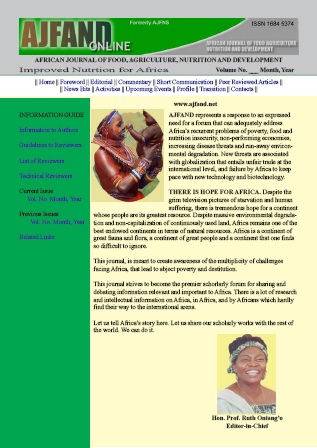
|
African Journal of Food, Agriculture, Nutrition and Development
Rural Outreach Program
ISSN: 1684-5358
EISSN: 1684-5358
Vol. 16, No. 2, 2016, pp. 10913-10935
|
 Bioline Code: nd16031
Bioline Code: nd16031
Full paper language: English
Document type: Research Article
Document available free of charge
|
|
|
African Journal of Food, Agriculture, Nutrition and Development, Vol. 16, No. 2, 2016, pp. 10913-10935
| en |
MORPHOLOGICAL DIVERSITY OF MANGO GERMPLASM FROM THE UPPER ATHI RIVER REGION OF EASTERN KENYA: AN ANALYSIS BASED ON NON- FRUIT DESCRIPTORS
Toili, Mary Esther M.; Rimberia, F.K.; Nyende, A.B. & Sila, D.
Abstract
Phenotypic variation in plants can be evaluated by morphological characterization using visual attributes. Fruits have been the major descriptors for identification of different varieties of fruit crops. However, even in their absence, farmers, breeders and interested stakeholders require to distinguish between different mango varieties. This study aimed at determining diversity in mango germplasm from the Upper Athi River (UAR) and providing useful alternative descriptors for the identification of different mango varieties in the absence of fruits. A total of 20 International Plant Genetic Resources Institute (IPGRI) descriptors for mango were selected for use in the visual assessment of 98 mango accessions from 15 sites of the UAR region of eastern Kenya. Purposive sampling was used to identify farmers growing diverse varieties of mangoes. Evaluation of the descriptors was performed on-site and the data collected were then subjected to multivariate analysis including Principal Component Analysis (PCA) and Cluster analysis, one- way analysis of variance (ANOVA) and Chi square tests. Results classified the accessions into two major groups corresponding to indigenous and exotic varieties. The PCA showed the first six principal components accounting for 75.12% of the total variance. A strong and highly significant correlation was observed between the color of fully grown leaves, leaf blade width, leaf blade length and petiole length and also between the leaf attitude, color of young leaf, stem circumference, tree height, leaf margin, growth habit and fragrance. Useful descriptors for morphological evaluation were 14 out of the selected 20; however, ANOVA and Chi square test revealed that diversity in the accessions was majorly as a result of variations in color of young leaves, leaf attitude, leaf texture, growth habit, leaf blade length, leaf blade width and petiole length traits. These results reveal that mango germplasm in the UAR has significant diversity and that other morphological traits apart from fruits can be useful in morphological characterization of mango.
Keywords
Mango; morphological characterization; Principal Component Analysis; IPGRI; eastern Kenya
|
| |
© Copyright 2016 - African Journal of Food, Agriculture, Nutrition and Development
Alternative site location: http://www.ajfand.net/
|
|
